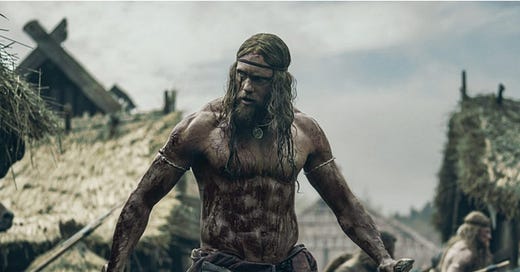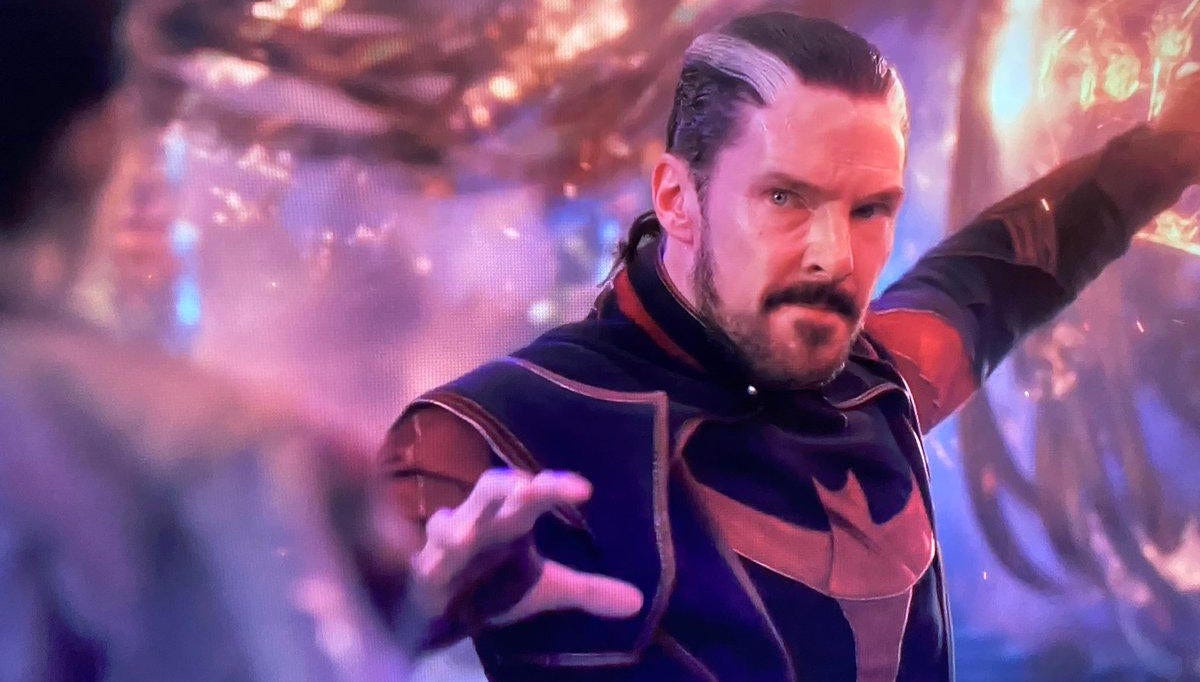The Northman (dir. Robert Eggers)
When you give Robert Eggers, the claustrophobic, macho-minded brain behind The Witch (2015) and The Lighthouse (2019), $70 million to make a Viking revenge epic, what happens? This is a question that has been plaguing eager fanboys and antsy studio executives alike, both hoping that the film will be a hit in the public domain. The answer, for better or worse—and despite reports that the studio forced Eggers to make the film more “entertaining” than what he wanted—is 137 minutes of ruthless, unapologetic, blood-spattering violence.
Lucky for us, that’s mostly a good thing. In a film world that worships grandstanding CGI and stagnant franchise properties, an original IP with star power and a singular directorial vision is unequivocally refreshing. Eggers delivers on the promise, too: if nothing else, The Northman is genuinely overwhelming in its intensity and scope, rendering an old Norse tale (the one that inspired Hamlet, in fact) with superb cinematic detail. It’s to the film’s credit that it doesn’t topple under its own epic weight. It does wobble, however—some necessary humanity is lost in the wolf-howling violence. A necessary side effect, perhaps, for a film unapologetically bent on vengeance.
Set in the seas and snows of 10th century Scandinavia, The Northman is brutally simple in its premise. King Aurvandill War-Raven (Ethan Hawke) dies at the hand of his treacherous brother Fjölnir (Claes Bang), who captures and forcibly marries his wife Gudrún (Nicole Kidman). Aurvandill’s son Amleth (played as a wide-eyed boy by Oscar Novak) escapes his uncle’s treachery and swears revenge. “I will avenge you, father; I will save you, mother; I will kill you, Fjölnir!” becomes his mantra as he leaves home, ready to grow into the bulldozer of a man that is Alexander Skarsgård.
The fully-grown Amleth is a being of pure, atavistic hatred, which Skarsgård conveys in bestial performance. Subtlety isn’t in Skarsgård’s dictionary, but neither is it in Amleth’s—it is a suitably one-note performance for a one-note character. The film falters most when it asks Amleth to do more than hate, as when he falls in love with the beautiful blonde slave Olga (Anya Taylor-Joy). Though Taylor-Joy is up to the task of complexifying an archetype, Skarsgård fails to transcend his singular vengeance.
It’s a relief, then, that the film focuses less on these moments of intimacy than of dude-bro Viking violence. The Northman body slams its straightforward setup into oblivion, turning the historical accuracy of Eggers’ previous films up to a testosterone-fueled eleven. The rank putridity of the Icelandic mud, the sensuousness of Norse pagan ceremonies, Skarsgård’s rage-infused animalism—each component is scrutinized to perfection, aimed at telling a revenge tale of unparalleled bombast. Sometimes, the results are astonishing. The film’s best sequence—a berserker raid upon a Rus’ village—begins with the much-publicized image of Skarsgård catching a spear and pulling a pinpoint return-to-sender. Yet this is only the beginning of a phenomenal bravura display: a single-take shot follows Amleth climbing up a wooden wall with nothing but an ax—masculinity at an animalistic maximum—before raining uncontrolled hell onto his enemies within. It is among the most visceral, gruesome, and unreservedly captivating action setpieces I have ever seen on the silver screen.
Other staggering moments of violence include a mythic moonlight battle with a Draugr (Scandinavian zombie), a fiercely competitive game of knattleikr (Scandinavian lacrosse), and, best of all, two naked Swedes fighting to the death atop an active volcano (Scandinavian Revenge of the Sith). And this is to say nothing of the hallucinatory coming-of-age ritual that opens the film, with a howling Aurvandill and a cackling jester (played expertly by Willem Dafoe); nor of Björk’s blink-and-you’ll-miss-it turn as an otherworldly seeress that guides Amleth back to his fate; nor again of the film’s recurring visions of glorious Valhalla. These are both the film’s strength and its weakness: so much happens, all of it enthralling—but there is never quite enough room to breathe.
The Northman’s unabashed Viking violence seems not to have stuck with audiences. At a time when Michael Bay’s Ambulance—another mid-budget original action thriller from an established auteur—failed to cash in on its promise, the death knell has been sounded for original action blockbusters. But for those seeking genuinely innovative thrills, The Northman delivers. Eggers and Skarsgård will take you from stormy seas to skeleton crypts before finishing with—it bears repeating—two naked Swedes fighting atop an active volcano. If that isn’t epic, I don’t know what is. —James Fahey
Doctor Strange in the Multiverse of Madness (dir. Sam Raimi)
To remark upon the unremarkable requires significantly more effort than one might think. Such is the conundrum facing the critic when reviewing the latest from Kevin Feige’s production line. Dr Strange in the Multiverse of Madness is, like margarine, neither particularly disappointing nor particularly exciting—it just is. Mediocrity? Perhaps, but the draw with this particular Marvel picture is director Sam Raimi, known for his early low-budget Evil Dead (1981), the later mid-budget Evil Dead 2 (1987), and the (first two) Tobey Maguire Spider-Man (2002-2004) films. Raimi’s signature style is present in this latest Dr Strange, although, subject to Feige’s rigid house style, finds itself formed and reformed like so much canned tuna.
Multiverse of Madness takes place where the painful corporate mediocrity Spider-Man No Way Home left off, where things have basically been put right after the previous exercise in cosmic meddling. Shock-horror, things go awry, there is a villain to defeat (this time in the form of Elizabeth Olsen’s Wanda Maximoff), characters grow, and the world is put right once again. That is, until the end-credits sequence where Charlize Theron appears to inform Dr. Strange that things must be, if you can imagine such a thing, put right again, as she opens a portal to yet another rose-tinted CG netherworld.
What is there left to say about these Marvel products? The previous, No Way Home, was nigh unbearable, replete with cheap market research-led attempts to reference Raimi’s popular Maguire movies and the fan culture that cherishes them. Multiverse of Madness is still noticeably samey, even if Raimi’s style is visible and will likely please fans of his earlier superhero pictures. Perhaps his particular aesthetic vision is a better fit for Marvel’s comic strip world than Nomadland’s Chloe Zhao, for example. His affection for the source material is clear, and followers will surely enjoy all the shaky POV shots, mischievous demons, and a cameo appearance from Bruce Campbell doing a slapstick bit as a bumbling food vendor. Maybe in decades to come, time will afford Feige’s films a certain novelty value, like Louis B. Mayer’s favourite Andy Hardy pictures. Who can say? Or rather, who has the enthusiasm to wonder?
—Alexander Ferrier






I've just watched both films and they both feel pretty generic (probably caused by my high expectations for Anya and Benedict). As to me, Dr Strange 2 feel like a rehashed version of the latest Spider-Man, only Marvel switched up the heroes I have to say, and the multiverse concept seemed like a surrealist reboot.It's certainly not a new concept, but it is impacting our brains and our vision through cinematic special effects.